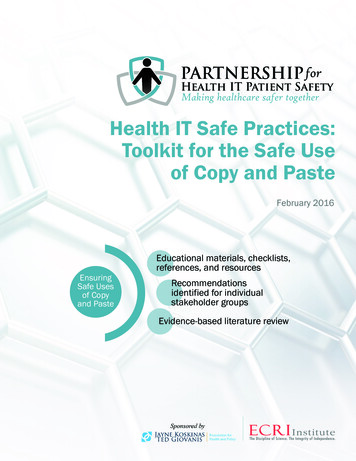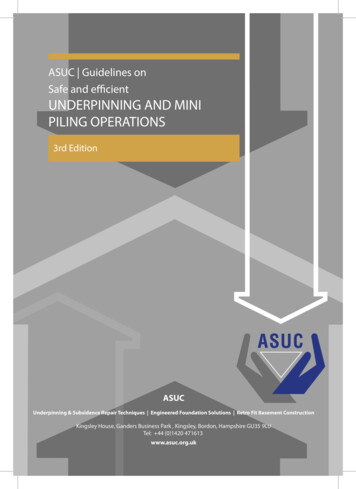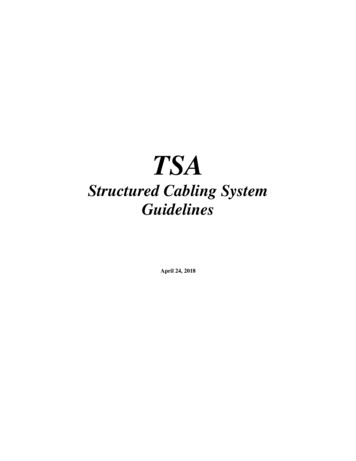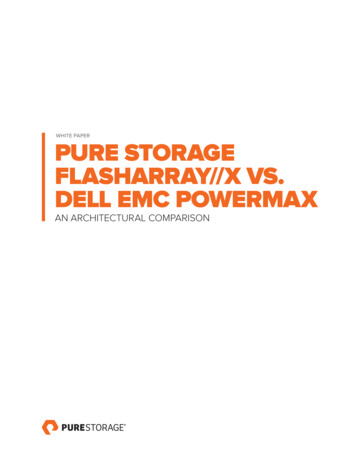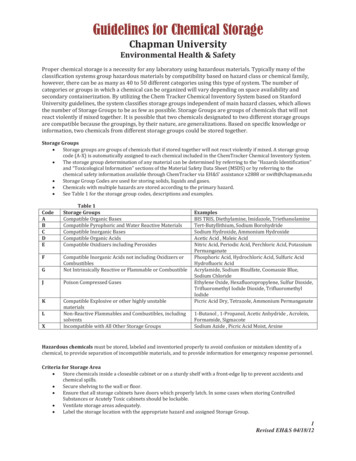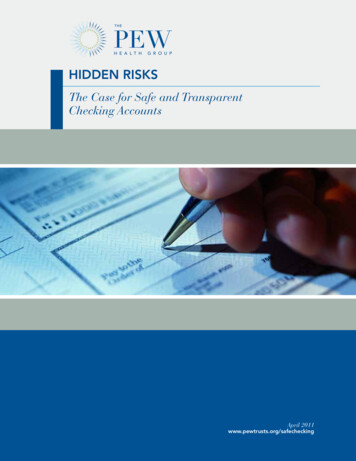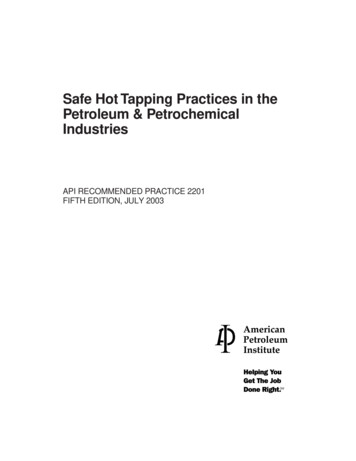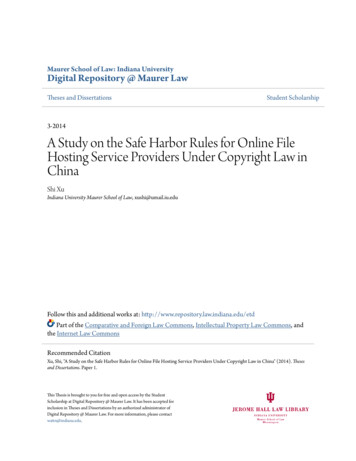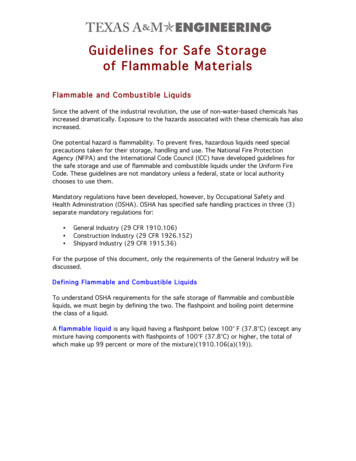
Transcription
Guidelines for Safe Storageof Flammable MaterialsFlammable and Combustible LiquidsSince the advent of the industrial revolution, the use of non-water-based chemicals hasincreased dramatically. Exposure to the hazards associated with these chemicals has alsoincreased.One potential hazard is flammability. To prevent fires, hazardous liquids need specialprecautions taken for their storage, handling and use. The National Fire ProtectionAgency (NFPA) and the International Code Council (ICC) have developed guidelines forthe safe storage and use of flammable and combustible liquids under the Uniform FireCode. These guidelines are not mandatory unless a federal, state or local authoritychooses to use them.Mandatory regulations have been developed, however, by Occupational Safety andHealth Administration (OSHA). OSHA has specified safe handling practices in three (3)separate mandatory regulations for: General Industry (29 CFR 1910.106)Construction Industry (29 CFR 1926.152)Shipyard Industry (29 CFR 1915.36)For the purpose of this document, only the requirements of the General Industry will bediscussed.Defining Flammable and Combustible LiquidsTo understand OSHA requirements for the safe storage of flammable and combustibleliquids, we must begin by defining the two. The flashpoint and boiling point determinethe class of a liquid.A flammable liquid is any liquid having a flashpoint below 100 F (37.8 C) (except anymixture having components with flashpoints of 100 F (37.8 C) or higher, the total ofwhich make up 99 percent or more of the mixture)(1910.106(a)(19)).
Safe Storage of flammable MaterialsPage 2 of 12Flammable liquids are categorized into three groups, as follows:Class IA Flammable LiquidLiquids having flashpoints below 73 F (22.8 C) and having boiling points below 100 F(37.8 C) (1910.106(a)(19)(i)). Examples: Acetaldehyde, ethyl ether andcyclohexane.Class IB Flammable LiquidLiquids having flashpoints below 73 F (22.8 C) and having boiling points at or above100 F (37.8 C) (1910.106(a)(19)(ii)). Examples: Acetone, benzene and toluene.Class IC Flammable LiquidLiquids having flashpoints at or above 73 F (22.8 C) and below 100 F (37.8 C)(1910.106(a)(19)(iii)). Examples: Hydrazine, styrene and turpentine.A combustible liquid is any liquid having a flashpoint at or above 100 F (37.8 C)(1910.106(a)(18)). Combustible liquids are divided into two classes:Class II Combustible LiquidLiquids having flashpoints at or above 100 F (37.8 C) and below 140 F (60 C),except any mixture having components with flashpoints of 200 F (93.3 C) or higher,the volume of which make up 99 percent or more of the total volume of the mixture(1910.106(a)(18)(i)). Examples: Acetic acid, naphtha and stoddard solvent.Class III Combustible LiquidLiquids having flashpoints at or above 140 F (60 C) (1910.106(a)(18)(ii)). Class IIIliquids are subdivided into two subclasses:Class IIIA Combustible LiquidLiquids having flashpoints at or above 140 F (60 C) and below 200 F, except anymixture having components with flashpoints of 200 F (93.3 C) or higher, the totalvolume of which make up 99 percent or more of the total volume of the mixture(1910.106(a)(18)(ii)(a)). Examples: Cyclohexanol, formic acid and nitrobenzene.Class IIIB Combustible LiquidLiquids having flashpoints at or above 200 F (93.3 C) (1910.106(a)(18)(ii)(b)).Examples: Formalin and picric acid. Per 1910.106(a)(18)(ii)(b) "Class IIIB liquids"shall include those with flashpoints at or above 200 F (93.3 C). This section doesnot cover Class IIIB liquids. Where the term "Class III liquids" is used in the section, itshall mean only Class IIIA liquids. (Class IIIB is used in this document for referencepurposes only.)*Note: When a combustible liquid is heated for use to within 30 F (16.7 C) of itsflashpoint, it shall be handled in accordance with the requirements for the nextlower class of liquids (1910.106(a)(18)(iii)).
Safe Storage of flammable MaterialsPage 3 of 12Whether a liquid is a Class IB Flammable Liquid or Class IIIA Combustible Liquid is notthe only factor you should consider when determining your safe storage needs. Youalso need to consider ignition temperature, explosive limits (LEL or UEL), vaporpressure, specific gravity and vapor density if you want to design a truly safestorage system.Flammable and Combustible Liquids Safety CansOne technique to reduce the hazards associated with flammable and combustible liquidsis the use of safety cans. OSHA defines a safety can as:"An approved container, of not more than 5 gallons capacity, having a springclosing lid and spout cover and so designed that it will safely relieve internalpressure when subjected to fire exposure" (1910.106(a)(29))."This definition allows a wide variety of containers to be considered safety cans. However,many local laws and insurance carriers require safety cans to be Factory Mutual (FM) orUnderwriter Laboratory (UL) approved. These two organizations are nationallyrecognized independent testing laboratories to which manufacturers submit products forevaluation of their ability to meet safety requirements under intended use. Products thatmeet the requirements are given either a UL product or FM approved. OSHA recognizesboth FM and UL.In addition, 29 CFR 1910.106 limits the amount of liquid in a single safety can. Thefollowing chart shows the allowable amounts for each class of liquid.MAXIMUM ALLOWABLE SIZE OF CONTAINERS AND METAL PORTABLE TANKSContainer TypeGlass or approvedplasticMetal (other thanDOT drums)Safety CansMetal Drum (DOTspec.)Approved MetalPortable TanksFlammable LiquidsClass IAClass IB1 pint1 quartCombustible LiquidsClass ICClass IIClass III1 gallon1 gallon1 gallon1 gallon5 gallon5 gallon5 gallon5 gallon2 gallon60 gallon5 gallon60 gallon5 gallon60 gallon5 gallon60 gallon5 gallon60 gallon660 gallon660 gallon660 gallon660 gallon660 gallon
Safe Storage of flammable MaterialsPage 4 of 12There are exceptions to this rule:1. Medicines, beverages, foodstuffs, cosmetics and other common consumerproducts, when packaged according to commonly accepted practice2. 29 CFR 1910.106 also limits the total amount of a liquid kept outside of a safetycabinet or storage room. The quantity of liquid that may be stored outside of aninside storage room or flammable liquid storage cabinets in any one fire area of abuilding cannot exceed:3. 25 gallons of Class IA liquids in containers4. 120 gallons of Class IB, IC, II or III liquids in containers5. 660 gallons of Class IB, IC, II or III liquids in a single portable tank6. The amount of liquid storage and location of cabinets is regulated. 1910.106(d)(3) states, "Not more than 60 gallons of Class I or Class II liquids, nor morethan 120 gallons of Class III liquids may be stored in a storage cabinet." Also,according to NFPA 304.3.2, not more than three (3) such cabinets may belocated in a single fire area.Storage CabinetsAnother fundamental means of fire protection is the use of flammable storage cabinets.The NFPA, OSHA and UFC require flammable cabinets to be designed and constructed tospecific requirements. 1910.106(d)(3)(ii)(a) states that flammable materials cabinetsshall be constructed in the following manner:1.2.3.4.5.Bottom, top and sides of cabinet shall be at least No. 18 ga. sheet steelCabinet must be doubled walled with 1½" airspaceJoints shall be riveted, welded or made tight by some equally effective meansDoor shall have a three-point latchDoor sill shall be raised at least 2" above the cabinet bottom to retain spilledliquid within the cabinet6. Cabinet shall have a "FLAMMABLE—KEEP FIRE AWAY" legendThese regulations also provide an option for wood cabinets. 1910.106(d)(3)(ii)(b)states that wood cabinets shall be constructed in the following manner:1. Bottom, top and sides of cabinet shall be at constructed of exterior gradeplywood at least 1" thick2. Plywood shall not break down or delaminate under fire conditions3. Joints shall be rebutted and fastened in two directions with flathead woodscrews4. When more than one door is used, they should have a rebutted overlap of notless than 1"5. Doors shall be equipped with latches and hinges that are mounted to not losetheir holding capacity when subjected to fire6. Door sill or pan shall be raised at least 2" above the cabinet bottom to retainspilled liquid within the cabinet7. Cabinet must have a "FLAMMABLE—KEEP FIRE AWAY" legend
Safe Storage of flammable MaterialsPage 5 of 12In addition to the requirements listed above, the UFC (Uniform Fire Code) alsorequires self-closing doors. Most local authorities use one or more of these standardsas a foundation for establishing local codes.Fire AreasOSHA does not provide a definition of a fire area in their standard. However, a fire area isdefined by NFPA Code 30 (1.6.15) as, "An area of a building separated from theremainder of the building by construction having a fire resistance of at least 1 hour andhaving all communicating openings properly protected by an assembly having a fireresistance rating of at least 1 hour."The NFPA also provides a special provision for the grouping of flammable cabinets in anindustrial facility. Because most industrial settings do not have walls or barriers within afacility, "In an industrial occupancy, additional cabinets may be located in the same firearea if the additional cabinets, or the group of not more than three (3) cabinets, isseparated from the other cabinets or group of cabinets by at least 100 feet (30 m)."(4.3.2 Exception 1)Flammable Combustible Liquids QuestionsEach year fires in homes and businesses destroy millions of dollars of property and claimnumerous lives. According to the U.S. Fire Administration, 2008 non-residentialstructures incurred approximately 112,000 fires resulting in 120 deaths, 1,400 injuries,and 3.8 billion in property losses. Non-residential structures are locations in which wemeet, learn, shop, and most of all work, outside our homes.Proper storage and handling of flammable liquids helps reduce the number of these nonresidential fires and keep losses to a minimum. OSHA compliant flammable liquid safetycabinets are designed to keep the containers stored inside at a lower temperature whileOSHA compliant safety cans safely relief pressure build-up and help prevent anexplosion.OSHA 29 CFR 1910.106 provides the definitions for flammable and combustible liquids.It provides information for the proper storage, stored amounts, and dispensing. Beloware answers to frequently asked questions regarding both mandatory requirements andbest practices for the safe storage of flammable materials:
Safe Storage of flammable MaterialsPage 6 of 12Venting of Storage CabinetsChemical storage cabinets, whether used for flammables, corrosives orpesticides/poisons, often come with capped bung openings that allow ventilation. Whilecabinet manufacturers may provide the bungs for venting, ventilation for chemicalstorage cabinets is NOT required or even recommended by any Federal regulatoryagency. Cabinet manufacturers include venting bungs for users who are required to ventby state or local codes, or by individual company or insurance carrier policies.Don’t Vent Unless You Have ToAccording to NFPA (National Fire Protection Association) Code 30, Flammable andCombustible Liquids Code Handbook, venting a chemical storage cabinet is not necessaryfor fire protection purposes. Flammable and combustible liquid storage cabinets aredesigned to protect the internal contents from a fire outside the cabinet. A ventedcabinet could compromise the ability of the cabinet to protect its contents from a fire.According to NFPA Code 30, 9.5.4*, "The cabinet is not required to be vented for fireprotection purposes."9.5.4.2, states; "If vented for whatever reason, the storage cabinet vent openings shallbe ducted directly to outdoors in such a manner that will not compromise the specificperformance of the cabinet and in a manner that is acceptable to the authority havingjurisdiction."9.5.4.1, states; “If the cabinet is not ventilated, storage cabinet vent openings shall besealed with the bungs supplied with the cabinet or with bungs specified by themanufacturer."NFPA Code 30 clearly dismisses the need to vent storage cabinets in its appendix. UnderA.9.5.4 it states, “Venting storage cabinets has not been demonstrated to be necessaryfor fire protection purposes. Additionally, venting a cabinet could compromise the abilityof the cabinet to adequately protect its contents from involvement in a fire sincecabinets are not generally tested with venting. Therefore, venting of a storagecabinet is not recommended."Federal OSHA recognizes the NFPA guidelines when it comes to chemical storagecabinets, so there’s no requirement to vent cabinets for OSHA compliance. However, thisdoes not mean it is not required in some circumstances. State and local authoritieshaving jurisdiction (AHJ) may require venting. NFPA 30 acknowledges this later inA.9.5.4., "However, it is recognized that some jurisdictions may require storage cabinetsto be vented and that venting may also be desirable for other reasons, such as healthand safety. In such cases, the venting system should be installed so as to not affectsubstantially the desired performance of the cabinet during a fire.Means of accomplishing this may include thermally actuated dampers on the ventopenings or sufficiently insulating the vent piping system to prevent the internaltemperature of the cabinet from rising above that specified. Any make-up air to thecabinet should also be arranged in a similar manner. If vented, the cabinet should be
Safe Storage of flammable MaterialsPage 7 of 12vented from the bottom with make-up air supplied to the top. Also, mechanical exhaustventilation is preferred and should comply with NFPA, Standard for Installation of Blowerand Exhaust Systems for Dust, Stock, and Vapor Removal or Conveying. Manifolding thevents of multiple storage cabinets should be avoided."How Do I Know If I Need To Vent My CabinetIn addition to acknowledging that the local AHJ requirements supersedes that of theNFPA, the above appendix passage identifies that venting is occasionally necessary andhow it can be achieved.The following five steps help to determine whether or not to vent a chemical storagecabinet: Determine Classification (Flammable, Corrosive and Oxidizer), health hazards,storage requirements (i.e. temperature, incompatibilities) and total amounts of thechemicals that will be stored in the cabinet. Refer to the Material Safety DataSheets (MSDS) for this information or contact the manufacturer/supplier forassistance. This information may be needed for the following steps.Contact your local Fire Marshal/Fire Inspector to determine if venting is required byyour local or state regulations. If so, obtain their instructions and any other specialrequirements.Contact your Environmental Health and Safety (EHS) Officer, if applicable. Manycompanies, universities, school districts and other large facilities have internalrequirements for venting and storage. Again, request instructions and specialrequirements since they may vary.Consult with your insurance company for their recommendations and requirements.Have air quality evaluated to determine actual explosive limit value in and aroundthe storage area. Consult an Industrial Hygienist for assistance. Your State OSHAConsultation Office will either provide you with an accredited hygienist that is onstaff, or will help you contact one in your area. If the cabinet’s contents are creating excessive levels of chemical vapors, it doesn’tnecessarily mean the cabinet must be vented. Before venting a cabinet to lower vaporemissions, consider the following options: Place cabinets in a cool, dry location out of direct sunlight and away from anypossible heat or ignition source. Temperature fluctuation in many chemicals willincrease harmful vapors emitted.Always maintain continuous and adequate room ventilation. Many accidents occurwhen ventilation is turned off for the weekend or an extended period of time.Maintain an accurate inventory of chemicals and their properties to preventdangerous reactions resulting from incompatible chemical storage. Never storechemicals solely based on alphabetization, as this can result in dangerouschemical reactions.Store chemicals only in containers that are made of materials determined to bechemically compatible so that leakage/damage will not occur. Consult the MSDSor manufacturer for their recommendations. Frequently inspect containers for
Safe Storage of flammable MaterialsPage 8 of 12 signs of damage and aging.Always make sure that caps are replaced on containers tightly, and that theoutside of containers is clean and free from residual liquids.Regularly inspect inside the cabinet for spills, and clean immediately if found.Regularly inspect cabinets and any metal items in surrounding area for signs ofrust, corrosion or other visual indications that the vapor levels are excessive andmechanical ventilation would be needed.Dispose of any aging chemicals that could become unstable.Use of vapor absorbent inside the cabinet can also reduce the irritant level ofvapors.What If I Have To Vent My Cabinet? If a decision is made to vent, follow the engineering guidelines from the AHJ thatrequires the venting. At the very minimum, venting should incorporate thefollowing steps:Remove both metal bungs from sides of cabinet and replace flame arresterscreens (normally these come with the cabinets) into the openings.Connect the bottom opening to the exhaust fan using rigid metal tubingequivalent or better than that used in construction of cabinet. Tubing must havean inner diameter no less than that of the opening. Several places require weldingof the tubing to the cabinet to avoid riveting or other methods that may impedethe cabinet’s fire protection. PVC should not be used since it cannot withstandexcessive temperatures.The top opening shall serve as the fresh air inlet. The make-up air should besupplied to the fresh air inlet in tubing similar to that used for the exhaust.A suitable fan should be constructed of non-sparking blades and shrouds.Mechanical exhaust ventilation is preferred and should also comply with NFPA 91Standard for Exhaust Systems for Air Conveying of Vapors, Gases, Mists andNoncompatible Particulate Solids.The total run of the exhaust duct should not exceed 25 feet.DO NOT manifold vents of multiple cabinets—in many localities it is prohibited.
Safe Storage of flammable MaterialsPage 9 of 12While the above guidelines refer most specifically to flammable liquid storage cabinets,they can be modified slightly for use on corrosive or pesticide/poison storage cabinets.Again, the AHJ that requires the venting needs to be consulted for engineering guidanceto ensure their specific venting protocol is met. A couple important points to rememberare corrosive cabinets require blowers that are chemically compatible with the vaporsthey move, and some pesticide/poison cabinets can not be vented to the outside due topotential health hazards associated with exposures to the vapors.Corrosive/Acid CabinetsThere currently are no regulations regarding the construction of corrosive/acid cabinets,however, most manufacturers construct them of either wood or polyethylene and theyare usually blue in color. The EPA does require that the cabinets be able to contain anypossible spills. Polyethylene is the most common material used for acid/corrosivecabinets. Chemical compatibility is the biggest reason to use this material along with thefact that polyethylene can be welded at the seams to provide better spill protection.Wood can be another choice of material for these cabinets, but chemical handling andstorage requirements should be closely evaluated since several acids are incompatiblewith wood and could ignite if spilled.
Safe Storage of flammable MaterialsPage 10 of 12Acid/Corrosive cabinets are primarily vented only when require
The NFPA, OSHA and UFC require flammable cabinets to be designed and constructed to specific requirements. 1910.106(d)(3)(ii)(a) states that flammable materials cabinets shall be constructed in the following manner: 1. Bottom, top and sides of cabinet shall be at least No. 18 ga. sheet steel 2. Cab

